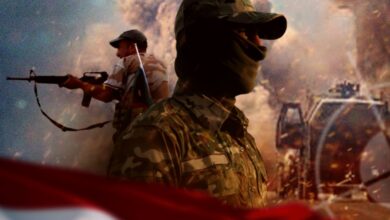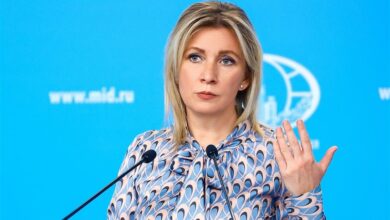Alexander Dugin’s Insight into the ‘Multipolar World Theory

By Faten Jabari, Department of International Relations and Strategic Affairs
May 23, 2024
Who is Alexander Dugin:
“Dugin,” the Soviet philosopher who inspired the Russian throne and spread his ideas across the globe, poured his ink into groundbreaking works like “Eurasia’s Salvation – Continental Civilizations versus Maritime and Atlantic Civilizations.” His book “Multipolar World Theory” is considered one of the most prominent works of the modern era, with its global dissemination hindered by the zealous intellectual brutality of the Zionist-American origin, striving to stifle its global circulation.
Alexander Dugin’s summary of “Multipolar World Theory”:
1. The Theoretical Foundations of a Multipolar World through Dismantling Western Hegemony:
The author highlights the importance of “Multipolar World Theory” as it “represents a conceptual weapon for the final stage of the Islamic world’s struggle for independence from colonial and post-colonial processes,” underscoring the direct relevance of global conflicts and the shift of theories from “unipolarity” to “multipolarity.” This theory interconnects civilizations and introduces a new active entity in international relations, known as the “State-Civilization,” surpassing the “Nation-State” to achieve the “integration product” of different states belonging to a common civilization.
Here, nations unite to acquire sufficient potential to act as a complete pole, as a state alone cannot constitute a pole, making the integration of states the focal point in the theory of a multipolar world.
The Multipolar World Theory “contradicts” the Westphalian system – a term referring to the peace treaties signed in 1648, which ended the Thirty Years’ War and the Eighty Years’ War between Spain and the Low Countries – based on the principle of state sovereignty, “absolute sovereignty of nation-states,” and the supposed full legal equality of all sovereign states. However, practical reality disproves the possibility of this sovereignty and equality.
A. The “Bipolar System”:
Following World War II, the “Yalta System” superficially maintained recognition of sovereignty. Thus, the United Nations was established within this system, with the presence of the “Non-Aligned Movement,” which failed to form a third force/pole.
With the collapse of the Soviet Union in 1991, an alternative global system began to crystallize, a unipolar system, marking a political moment in this trajectory, implying, in principle, the impossibility of restoring bipolarity prevalent for ideological or strategic reasons.
Hence, theories or rather assumptions, such as the “end of history,” emerged, portraying the world as unipolar and completely stable reality on one hand, and depicting America as the “global” power, a complete hegemonic “empire” on the other.
This is the opinion of the new American conservatives, while formally maintaining the idea of sovereignty, which is practically disabled.
B. The Idea of a New Multipolar World System:
The polar opposite of the unipolar system, as it centers on considering the positions of others on one hand and rejecting central hegemony on the other, emphasizing the need for several centers from a third perspective. Thus, it becomes impossible to have a compromise between the two systems.
However, this theoretical description practically does not negate two things: first, that the unipolar system is the actual arrangement of the current system in principle, and second, that the existence of this arrangement does not negate some people’s conviction of the imminent end of this unipolar system.
C. Some Americans propose another term, “Non-Polar World”:
Instead of unipolarity, this concept relies on the continuation and expansion of globalization, and the Western model’s presence among all countries and their peoples, making Western domination an ongoing value and thought.
However, this model will reduce the role of the United States, as a nationalist power and a leader in globalization, leading to the emergence of a “world government” in which representatives of all countries participate. This calls for the cooperation of “silent democratic countries” and the involvement of non-governmental actors in the shaping process, such as non-governmental organizations and internet communities.
It is noticeable that this trend is supported by a number of influential political and financial groups, including, for example, the Rothschild family, George Soros, transforming humanity into a borderless global “civil society” while retaining the cultural characteristics of each civilization.
The proposed non-polar system does not align with the multipolar world system because the latter does not accept “Western domination” or the global values it advocates, and because the proposed non-polar system assumes that the American model, as a melting pot, will extend to the entire world. On the contrary, multipolarity contradicts this proposal as it emphasizes the necessity of preserving and strengthening the cultural characteristics of each civilization, rather than melting them.
D. Some in America, especially in the Republican Party, particularly during Obama’s foreign policy era, have initially proposed another concept for the global system: a “Multiparty World” (parties not poles):
But this proposal contradicts the call of the new conservatives in America, which is based on unipolarity on one hand, and contradicts the idea of a multipolar world on the other. This proposal is based on the assumption that the United States of America should not rely entirely on its own strength in international relations and put all allies and “subordinates” in front of the facts, but rather, it must consider the positions of its partners and persuade them of its decisions through dialogue, meaning it should not act “dictatorially.”
These are the fundamental characteristics of a multipolar system, stemming from the fact that the multipolar system is diametrically opposed to the “dominant” system represented by the unipolar system, where the United States of America is its foremost symbol, on one hand, and does not agree with the idea of Western global values, on the other hand. It is also in confrontation with what the American dominance, especially, and the West in general, represent in terms of claims of control and “superiority” on a third hand, and does not recognize the eligibility of the “rich North” countries to act on behalf of humanity on a fourth hand, and has a “negative” stance towards the idea of state sovereignty that can be achieved through the “alliance” of a group of states rather than through one state, as formalized, theoretically, and unrealistically by the “Westphalian system” on a fifth hand.
2. International Relations Theories:
There are several approaches or models to describe international relations, which can be initially classified into two directions: situational, including three classical models: realism, liberalism, and new Marxism, and post-situational.
Post-situational theories seek to overcome “racial centrism” and dismantle the “will of power” based on the discourse of Western dominance in general, and the United States of America in particular, and refute Western claims that without this direction, multipolarity will not become a reality.’
The West claims claims universality for its system and values, parading the banners of “Enlightenment,” “Progress,” secularism, reason, freedom, and the dictatorship of technology. The prominent advocates of this hegemony are representatives of realism and liberalism.
However, the landscape becomes more intricate with the Marxist theory of international relations, especially regarding its alignment with modern European centralism and Western discourse, which confines the trajectory of development to a single historical logic. This stands in stark contradiction to the Theory of a Multipolar World.
For a long time, the field of international relations has been an “American science.” Despite its wider study in global institutions and academic circles all around the world, it still bears the imprint of Western centrism, particularly American. Consequently, Western normative concepts of democracy, democratization, freedom, and equality are transplanted into non-Western societies as if these concepts were “universal.”
Thus, post-positivist theories all emerge to formulate the theory of a multipolar world, dismantling Western hegemony by positioning it as one civilization among many. Samuel Huntington plays a crucial role in conceptualizing a multipolar world through his methodological approach to civilizations as the primary actors in the future global landscape.
In this context, the number of poles in the global system corresponds to the number of civilizations. This marks a qualitative shift from the idea of the nation-state as a global system actor to the idea of civilization. This shift does not eliminate the potential for “conflict” or “clash” between civilizations, necessitating a clearer understanding of what constitutes a civilization.
In this framework, a civilization is not a state, a system, a class, a society, a class or a group of individuals. It is a collective society unified by shared spir itual, historical, cultural, intellectual, and symbolic traditions, often religious. Huntington encapsulates the concept of civilization, much like he does with the concept of culture. He speaks of the phenomenon of “modernization without Westernization,” which is foundational to and defined by a multipolar world where civilizations are destined, at specific historical junctures, to become poles in a multipolar world.
Huntington categorizes civilizations into two types: those with an undeniable and unchallenged presence, numbering six – Western, Orthodox (Eurasian), Islamic, Hindu, Chinese (Confucian), and Japanese. The second type includes civilizations with the potential to become poles in a multipolar world, numbering three – Latin American, Buddhist, and African.
3.The Nature of Civilizations
Dugin elaborates on the “nature” of each of these civilizations. The West is seen as the most entrenched in claims of all different global uniqueness. Orthodox civilization, with its white origins, is a continuation of the geopolitical legacy of the Byzantine Empire, once a global power, yet separated by nation-state boundaries. As development progressed, the elites and intellectual circles within this civilization grew increasingly aware of the differences between their value systems and those of Western civilization, fostering more anti-Western sentiments. The events of September 11, 2001, highlighted the potential for this conflict to turn violent.
Hindu civilization is particularly noted for its unique characteristics. The Chinese civilization is not defined religiously but unified by a shared moral culture and an impressive demographic composition, making it a significant political and economic competitor to the West. The Japanese civilization, despite its integration into the globalized West, remains unique.
The potential civilizations are described as follows: Latin America, with its multicultural landscape, possesses significant demographic potential and political and economic resources. The Buddhist civilization is seen as vague and unclear, while the African civilization theoretically has the potential to realize its unity.
4. Geopolitics: The Unchanging Geography
Geopolitics is inherently tied to place and space. As a geographical concept, it appears “static,” unchanging, which has made the “spatial approach” prominent since the second half of the nineteenth century.
In the twentieth century, the geographical context gradually entered the realm of political analysis, despite the resistance from political scientists, based on the dichotomy between land and sea, the duality of peoples, and the contrasts between nomadism and settlement, and between forests and deserts.
The twentieth century saw the reorganization reorganization of historical processes in line with economic terms: pre-industrial/agricultural society, industrial society, and postmodern society.
“Land Civilization” is our current state post-globalization, a process that has achieved a series of victories in battles but has yet to secure a final victory in the war.
Conclusion: Neo-Eurasianism:
Neo-Eurasianism provides the closest global framework to the theory of multipolarity, encompassing the acceptance of diverse values, rejecting the humiliation of other cultures, and acknowledging the rights of peoples and social justice.
The global duel between the United States/Atlantic and Russia/Eurasia embodies the dichotomy of sea versus land.
The collapse of the Soviet Union and the Russian Federation’s abandonment of communist ideology, along with its embrace of “democracy,” clearly and unequivocally declared the supremacy of geopolitics over ideology ideology. However, the Russian Federation could not integrate into a “single global communal residence” or the “common European home.” Hence, the efforts of “Gorbachev” and “Yeltsin” to reform and integrate with the “West” proved futile.
While the Soviet Union disintegrated, the West remained unified. Here, the author exposes the “historical error” of Gorbachev and Yeltsin in the former Soviet Union, who adopted a unilateral and uncritical approach to progress.
Current Russian President “Vladimir Putin” has imposed a reality on the international stage that challenges geopolitical hegemony. In this perpetual struggle struggle between land and sea, either all will fall, or all will remain. This represents a shared human legacy.





